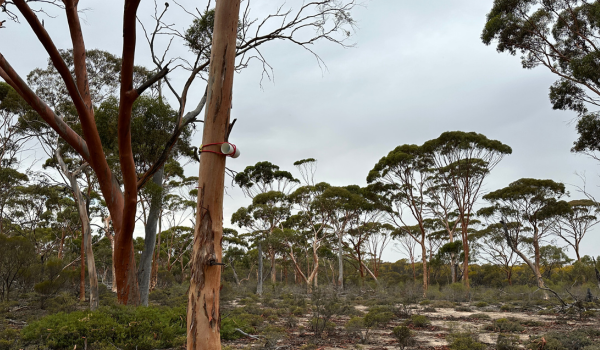Airborne eDNA Monitoring for Terrestrial Biodiversity with Wheatbelt NRM
Wheatbelt NRM partnered with EnviroDNA to deliver an innovative biodiversity survey using airborne eDNA monitoring across multiple sites in south-western Western Australia. Local citizen scientists were trained to deploy passive sampling devices, which were fixed to trees for one month. We processed these samples using DNA metabarcoding to identify vertebrate species.
Christmas Island Blue-Tailed Skink Detection to Support Recovery Efforts
The Christmas Island Blue-Tailed Skink (Cryptoblepharus egeriae) is a Critically Endangered species listed on the EPBC list, endemic to Christmas Island. Parks Australia aimed to support recovery efforts by using eDNA techniques to detect both the skink and its known cryptic predator – the wolf snake (Lycodon capuchinus).
Border Ranges Lined Fern Detection using eDNA
Tweed Landcare engaged EnviroDNA on a monitoring project for the Border Ranges Lined Fern using eDNA. This is an epiphytic fern that grows on the surface of volcanic boulders and tree trunks in subtropical rainforests. It’s listed as Critically Endangered on the EPBC list, having an extremely limited distribution only occurring on the border of QLD and NSW.
Detection of Greater Glider in Queensland using eDNA
The City of Moreton Bay partnered with EnviroDNA to improve detection of Greater Gliders using eDNA. EnviroDNA developed a targeted qPCR assay to support more precise sampling and improve detection reliability. Multiple sample types were investigated, including water, scat, and tree hollow swabs.
Monitoring Freshwater Turtles using eDNA
BMRG in Queensland partnered to better understand the distribution of freshwater turtles, focusing on the White-throated Snapping Turtle (Elseya albagula) and the Mary River Turtle (Elusor macrurus). EnviroDNA was engaged to apply the Threatened Species Detection Matrix, a tool that assesses the likelihood of successfully detecting a species using eDNA.
Rapid Detection of Avocado Priority Pests with eDNA
Funded by Hort Innovation, this project developed eDNA technologies for the rapid detection and identification of priority pests for the avocado industry. DNA-based testing techniques aim to improve the ability of the avocado industry to quickly and accurately identify pest incursion threats in a cost-effective manner.
The Great Australian Wildlife Search
The Great Australian Wildlife Search is an ambitious project using citizen science and eDNA monitoring to address significant knowledge gaps in biodiversity throughout Australia. Traditional methods for monitoring over large areas can be challenging due to their high costs, labor-intensive nature, and time-consuming processes.
Rapid eDNA Detection of Priority Sugarcane Pests
This project partners with Sugar Research Australia to explore simple environmental sampling approaches to indirectly identify species that have recently been in an area, or to directly identify species that are difficult to identify by non-genetic methods.
Baseline Data for the Budj Bim Cultural Landscape
The Budj Bim landscape is located on Gunditjmara Country in southwest Victoria, Australia. This area is an extremely culturally significant landscape and is home to a range of native and threatened species. eDNA surveys were used to survey the extensive landscape area in a quick and cost-effective way whilst gaining critical biodiversity data to assist in future management and planning decisions.
Discovering Nature Through eDNA: From Creek to Classroom
Funded by the Victorian Junior Landcare Biodiversity Grants, students engaged in hands-on biological research and water sampling. Key outcomes included real-world ecological project participation, field sampling experience and enhanced understanding of DNA and conservation. These projects encouraged students to explore their local ecosystems, fostering awareness of biodiversity and conservation.
Natural Capital Monitoring in the Burnett Mary Region
Burnett Mary Regional Group is undertaking a biodiversity assessment for native fauna as part of a project developing a comprehensive environmental account of natural assets in the region. This project applies an EnviroDNA Method under the Accounting for Nature framework that uses eDNA to support large scale monitoring.
Tracking gastrointestinal pathogens in remote Papua New Guinea communities
This project evaluated the water quality of remote sites in Papua New Guinea, using SourceDNA to track gastrointestinal pathogens in waterways and understand catchment health for the conservation forest and human communities.













